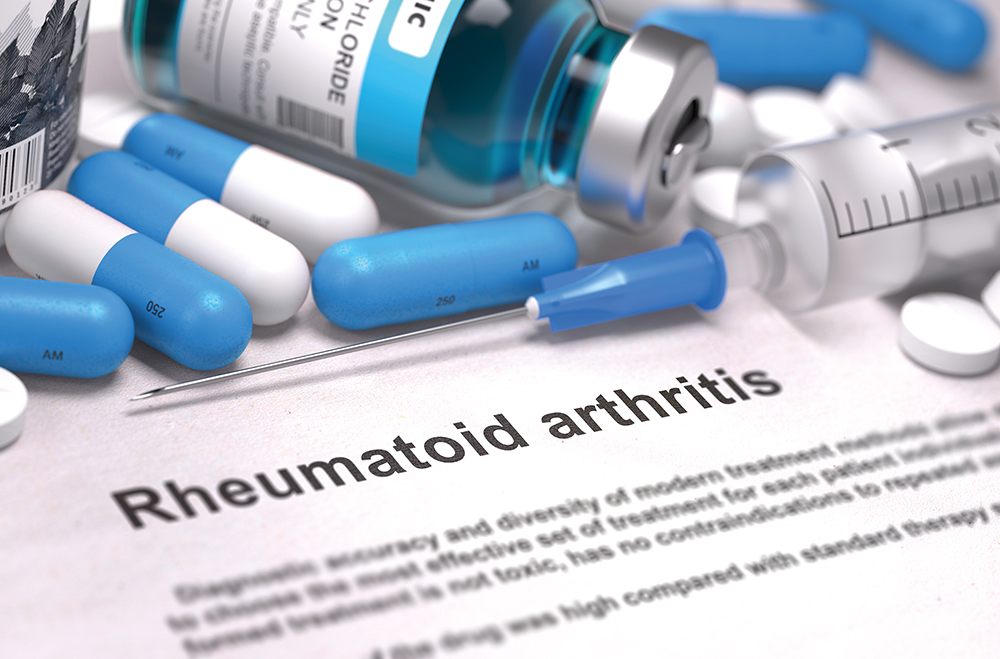Professor Hani El-Gabalawy – Emerging Approaches to the Detection and Prevention of Rheumatoid Arthritis in a Predisposed Indigenous North American Population
Rheumatoid arthritis (RA) is a long-term, systematic disease that causes pain, swelling and stiffness in the joints. Professor Hani El-Gabalawy and his research team from the University of Manitoba in Canada are finding ways of better identifying those at risk for future RA as a prelude to developing and testing prevention strategies. Since other autoimmune diseases are known to have similar preclinical phases, prevention strategies that can effectively lower the risk of developing RA can potentially be adapted and applied to a broad range of similar disorders.
Prevalence and Impact of Rheumatoid Arthritis (RA)
Autoimmune diseases represent a heterogeneous group of chronic disorders affecting about 5% of the population and in which the immune system targets one’s own body tissues causing progressive damage to tissues and organs. Rheumatoid arthritis (RA) is one of the most prevalent autoimmune diseases worldwide, and once established, it is typically a lifelong disease that can be suppressed effectively with medications but not cured.
Although RA is usually first diagnosed in clinical settings when individuals present with swollen and painful joints, it is now known that this is preceded by a prolonged preclinical phase where genetic and environmental factors interact to initiate the damaging autoimmune mechanisms that ultimately lead to disease. It is speculated that the detection of RA autoimmunity at this preclinical phase may afford opportunities for disease prevention and cure that cannot otherwise be achieved once RA is fully established.
Studies of RA in Indigenous North American (INA) Peoples
Many (but not all) Indigenous Peoples in North America exhibit disproportionately high rates of RA. A recent analysis from a large healthcare database in the Canadian Province of Manitoba showed that RA is 2–3 times more prevalent in Indigenous Peoples living in the Central Plains region (Cree, Ojibwa, Oji-Cree, Anicinabe and Dene), collectively known in Canada as First Nations (FN), compared to all other non-FN Manitobans. Furthermore, this FN population exhibits a much younger age of disease onset, frequent clustering of RA cases in families, and a tendency towards severe, rapidly disabling disease based on the frequent involvement of large joints such as the knees, elbows, shoulders, and hips. Thus, this common autoimmune disease is particularly devastating in the FN population, and understanding the biological basis of this is a key first step to improving the outcomes.
Gene-environment Interactions That Promote RA Autoantibody Development
The hallmark of many autoimmune diseases is the development of specific autoantibodies by the immune system that target normal self-antigens. In targeting self-antigens, these rogue autoantibodies are capable of continually activating the full force of the body’s inflammatory response, a powerful tool which is designed to rapidly and efficiently eliminate harmful bacteria and viruses. This inappropriate and unchecked autoimmune-mediated inflammation then causes irreversible damage to the cells, tissues, and organs that express their targeted self-antigen.
Autoimmune diseases become chronic and lifelong because the self-antigens, by their nature, always persist and cannot be eliminated the way that microbes are eliminated. Once the immune system develops a ‘distaste’ for a self-antigen and targets it, the response becomes exceedingly difficult to turn off and tends to amplify over time.
In RA, the most specific autoantibodies are anti-citrullinated protein antibodies (ACPA). The targets of these ACPA are proteins that contain the amino acid citrulline. Citrulline is generated in multiple proteins by a normal enzymatic reaction called citrullination where the amino acid arginine is slightly modified. Although the physiological roles of this common process continue to be explored, citrullination is an entirely normal biochemical reaction that occurs in everyone during inflammation and normal cell death. It can perhaps be thought of as part of the body’s garbage collection system where specific proteins are marked for waste disposal.
So why do citrullinated proteins become the target of RA autoantibodies? Multiple studies over the past 3 decades clearly point to specific interactions between an individual’s genetic makeup and environmental factors. Both the genetic and environmental factors are quite common, and each alone is insufficient to generate RA autoimmunity.
More than one hundred different genes are associated with an increased risk of RA. Of these, the HLA genes are by far the most powerful predisposing genetic factors. HLA genes are responsible for making HLA proteins that are expressed on the surface of immune cells and regulate normal immune responses, particularly those of the adaptive immune system which generates immune memory. Individual variations in HLA genes are the reason why one individual can respond to a specific microbe in a highly effective manner while the next individual mounts a weaker and less effective response.
Specific variants of the HLA-DRB1 gene (and in turn, the surface proteins it encodes) are the primary risk factor for RA. There are several HLA-DRB1 variants known to be associated with RA in populations worldwide, most of which have a common amino acid sequence in their structure which has been termed the ‘shared epitope’ (SE). Individuals carrying HLA-DRB1 variants with this SE sequence are more likely to recognize and process autoantigens containing the amino acid citrulline in their sequence and then activate the immune system to respond to these proteins in an inflammatory manner.
Predisposed First Nations have a particularly high prevalence of HLA-DRB1*1402, an SE encoding allele that is essentially unique to the FN population. It is overrepresented in multiple Indigenous North American populations, all of which seem to have an increased risk of developing RA. The reasons why this HLA allele is so common in INA populations are intriguing and suggest that it may have afforded a survival advantage, possibly through enhanced immunity to particular infections, such as those brought to the New World from the Old World. Studies of skeletal remains before colonization suggest that RA may have been present in the Americas for thousands of years, whereas it did not appear in the Old World until after the Americas were colonized. Thus, HLA-DRB1*1402 may be the ultimate two-edged sword where increasing protecting from a deadly infectious disease are achieved at the expense of increased risk for developing the RA autoimmune disease.
To better understand the risk of RA development in FN People, and with uninterrupted funding from the Canadian Institutes of Health Research, in 2005 Professor Hani El-Gabalawy and his research team from the University of Manitoba established a prospective longitudinal cohort study of the close relatives of FN RA patients. This research methodology allows the study of individuals over time, and the aim here was to identify individuals at highest risk for developing future RA and follow them into disease onset. In turn, this would improve the understanding of how the autoimmune mechanisms that are established during the preclinical phase evolve and ultimately lead to the development of the highly destructive RA phenotype that is seen in this predisposed population. Fifteen years later, when the study participants who developed the earliest stages of RA were compared to the large number who did not, important insights were gained into how RA starts, and which autoimmune mechanisms need to be interrupted to potentially prevent onset.

Tools with Which to Study the Preclinical Phase of RA
Seminal retrospective studies from Sweden and the Netherlands showed that individuals who ultimately developed RA had detectable autoantibodies in their stored serum samples which had been obtained at the time of donating blood. Studies of stored serum samples available in a large repository obtained from USA military personnel have demonstrated similar findings, both for RA and the related autoimmune disease systemic lupus erythematosus (lupus). In all cases, the levels of the autoantibodies increased as disease onset approached, while the scope of self-antigens that were targeted by the autoantibodies expanded.
The majority of the known environmental risk factors for RA and lupus have been identified through case-control studies, in which diagnosed patients are directly compared with healthy individuals. Although this method has limitations because the data are collected primarily from the patient’s recollection of exposure to environmental factors (and thus may not be entirely accurate), it is still very useful in exploring the association of an autoimmune rheumatic disease (ARD) with a specific risk factor. Notably, tobacco smoke has been identified as a strong risk factor for RA in several studies. However, whether smoking contributes to the initiation or propagation of RA still needs to be determined.
Predicting the Development of RA
Since ACPAs are a good biomarker for the imminent onset of RA, Professor El-Gabalawy’s research team explored this further. The SE may contribute to an increased immune response against citrulline-expressing cells, but it does not explain the high levels of ACPAs in seemingly healthy individuals with no clinical evidence of the disease.
A study published in 2019 further refined the concept of RA biomarkers by characterising which ACPA molecules are associated with a higher risk of developing RA. It was confirmed that ACPA that feature additional sugar molecules in their structure called N-glycans are a particularly strong predictor of developing future RA. The ACPA, like all other antibodies, are produced by B lymphocytes and their offspring cells called plasma cells. In a normal immune system, the B lymphocytes go through consecutive cycles of maturation after being exposed to their target antigens to produce antibodies with a high affinity for the antigen so as to effectively eliminate bacteria and viruses. The addition of the N-glycans seems to be unique to the ACPA but does indicate that the B lymphocytes that produced these antibodies have undergone cycles of maturation, with the help of other lymphocytes called T helpers. Why this maturation occurs to produce antibodies again a self-antigen remains unclear and is an area of active research in several laboratories around the world.
Professor El-Gabalawy hypothesised that the detection of N-glycans in ACPA seropositive individuals could therefore serve as a better biomarker for future RA development and help improve the predictive capacity of the ACPA testing. Besides ACPA autoantibodies, the group also found multiple other proteins circulating in the blood that could further improve this predictive capacity and allow for targeting prevention treatments to individuals at highest risk for developing RA.
The Development of Inflammatory Arthritis (IA) in Relatives
RA in Indigenous Peoples tends to run in families, with a clustering of RA antibodies and inflammation markers found in first-degree relatives of RA patients. In a study published in 2019, Professor El-Gabalawy and his colleagues followed relatives with RA for 12 years and reported the link between the development of inflammatory arthritis (IA) and the prevalence of autoantibodies in FN families with RA. The study showed that relatives of patients with RA have an increased likelihood of being seropositive for ACPAs and rheumatoid factor (RF), and also for developing IA.
However, findings indicated that the prediction of RA based on autoantibodies should be approached cautiously, as these prospective observations indicated that a very large proportion of patients that were initially positive for either or both ACPA and RF tested negative after 5 years. Despite a high incidence of IA in the Indigenous (FN) families with RA, seropositive individuals did not necessarily develop IA and might even revert to a seronegative state, reflecting an absence of the antibodies found in seropositive patients.
Therapeutic Strategies and Limitations of the Detection of Autoantibodies
Although identifying at-risk populations is critical to disease prevention, commercial assays are progressively being developed that increase the sensitivity and specificity of the diagnosis of RA. Double seropositivity for both ACPAs and RF is associated with the highest probability of developing IA. Some therapeutic strategies aim to reduce specific circulating autoantibodies and there are many on-going clinical trials currently testing different drugs such as hydroxychloroquine for their disease modifying effects.
The likelihood of becoming seronegative, after showing the presence of detectable ACPA, suggests that the current understanding of RA based only on the presence of ACPAs and RF seropositivity is insufficient. Therefore, it is necessary to continue the study of the earlier phase of autoimmune disease, via prospective and longitudinal studies, to provide clinically actionable guidelines for ARDs. Professor El-Gabalawy and his team are hard at work to gather such prospective data on at-risk individuals to understand both the development and the evolution of this disease, and to develop biomarkers that improve both diagnosis and prognosis in ARDs such as RA.
Reference
https://doi.org/10.33548/SCIENTIA627
Meet the researcher

Professor Hani El-Gabalawy, MD FRCPC FCAHS
University of Manitoba Arthritis Centre
Winnipeg, Manitoba
Canada
Professor Hani El-Gabalawy obtained his medical degree at the Faculty of Medicine at the University of Calgary in 1977, followed by his Internal Medicine training and Rheumatology Fellowship at Dalhousie and McGill Universities. In 1997, as a visiting scientist at the National Institute of Arthritis and Musculoskeletal and Skin Diseases (NIAMS) in Bethesda, Maryland, Professor El-Gabalawy developed expertise in leading a large and complex research project focused on the early stages of inflammatory arthritis. In 2000, he returned to the University of Manitoba where he initiated a research program in the area of pathogenesis and prognosis of early inflammatory arthritis, with a particular focus on Indigenous North American populations that exhibit a disproportionately high burden of rheumatoid arthritis. From 2013–2017 Professor Hani El-Gabalawy served as the Scientific Director of the Canadian Institutes of Health Research (CIHR) Institute for Musculoskeletal Health and Arthritis. As a Professor of Medicine and Immunology, senior clinician-scientist, and Endowed Rheumatology Research Chair at the University of Manitoba, his research program continues to receive prestigious funding support for ongoing research in the prediction and prevention of rheumatoid arthritis in susceptible Indigenous North American People. Professor El-Gabalawy has received a large number of awards for his important contributions to the field of rheumatoid arthritis.
CONTACT
E: hani.elgabalawy@umanitoba.ca
W: http://umanitoba.ca/faculties/health_sciences/indigenous/institute/research/11041.html
KEY COLLABORATORS
Dr Josée Lavoie, Professor and Director, Director, Ongomiizwin Research, University of Manitoba
Dr Rene Toes, Professor of Rheumatology, Leiden University, Netherlands
Dr Ranjeny Thomas, Professor of Medicine, University of Queensland, Brisbane, Australia
Dr Marvin Fritzler, Professor of Medicine, University of Calgary, Canada
FUNDING
New Brunswick Medical Research Fund
Health Sciences Centre Foundation
The Thorlakson Foundation
NIH, Intramural Research Program
NIH Clinical Center Bench to Bedside award
AstraZeneca
Medimmune Inc
Networks of Centres of Excellence, Canadian Arthritis Network
The Arthritis Society
Canadian Institutes of Health Research
FURTHER READING
O’Neil LJ, Spicer V, Smolik I, et al., A Serum Protein Signature is associated with Rheumatoid Arthritis development, Arthritis & Rheumatology, 2020, doi:10.1002/art.41483
S Tanner, B Dufault, I Smolik, et al., A prospective study of the development of inflammatory arthritis in the family members of Indigenous North American people with rheumatoid arthritis, Arthritis & Rheumatology, 2019, 71(9), 1494–1503.
L Hafkenscheid, E de Moel, I Smolik I, et al. N-linked glycans in the variable domain of ACPA-IgG predict the development of rheumatoid arthritis, Arthritis & Rheumatology, 2019, 71(10), 1626–1633.
SW Scally, SC Law, YT Ting, et al., Molecular basis for increased susceptibility of Indigenous North Americans to seropositive rheumatoid arthritis, Annals of the Rheumatic Diseases, 2017, 76(11), 1915–1923.
KD Deane, H El-Gabalawy, Pathogenesis and prevention of rheumatic disease: focus on preclinical RA and SLE, Nature Reviews Rheumatology, 2014, 10(4), 212–28.
C Peschken, CA Hitchon, D Robinson, et al., Rheumatoid Arthritis in a North American Native Population: Longitudinal Follow-up and Comparison with a Caucasian Population, Journal of Rheumatology, 2010, 37, 1589–95.

Want to republish our articles?
We encourage all formats of sharing and republishing of our articles. Whether you want to host on your website, publication or blog, we welcome this. Find out more
Creative Commons Licence
(CC BY 4.0)
This work is licensed under a Creative Commons Attribution 4.0 International License. 
What does this mean?
Share: You can copy and redistribute the material in any medium or format
Adapt: You can change, and build upon the material for any purpose, even commercially.
Credit: You must give appropriate credit, provide a link to the license, and indicate if changes were made.
More articles you may like
Grandmothers: Innovation Through Tradition
Grandmother Project – Change through Culture (GMP) is an organisation dedicated to documenting the role of grandmothers and demonstrating the effectiveness of grandmother-inclusive strategies in improving the health and well-being of women, children, and adolescents. GMP’s groundbreaking work challenges conventional wisdom to transform community-based interventions in Africa and beyond, harnessing a powerful but often overlooked resource: the wisdom and influence of grandmothers.
Dr Robert Larkin | Cultivating Change to Improve Soil Health and Increase Potato Yield
Environmental quality and food production are facing the pressing challenges of climate change and global population growth. Dr Robert Larkin from the United States Department of Agriculture-Agricultural Research Service (USDA-ARS) and a team of plant scientists developed and tested a range of crop management systems to help overcome these compounding challenges. Their work is improving soil health and increasing the yield of potato crops, contributing to the future food security of nations.
Professor Giorgio Buttazzo | Artificial Intelligence and a Crossroads for Humanity
Where do we stand with artificial intelligence? Might machines take over our jobs? Can machines become conscious? Might we be harmed by robots? What is the future of humanity? Professor Giorgio Buttazzo of Scuola Superiore Sant’Anna is an expert in artificial intelligence and neural networks. In a recent publication, he provides considered insights into some of the most pressing questions surrounding artificial intelligence and humanity.
Dr Ralf Adam | New Technologies Shaping the Future of Oral Hygiene
Understanding the efficiency of various toothbrush technologies is essential for achieving optimal oral health. Dr Ralf Adam, who leads a dedicated team at Procter & Gamble in Germany, is keen to investigate the complexities of these technologies. His team have provided new insights into the best toothbrush types for plaque removal and the maintenance of gum health. By highlighting the importance of informed oral care decisions and ongoing investigations, this vital research works towards ensuring everyone can achieve a brighter, healthier smile.




